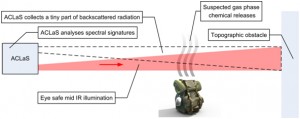The recent terrorist incidents at the Boston marathon in the US have highlighted once again the real danger to society from chemical attacks and explosive devices in urban settings. The detection of chemicals in the air by remote means is of great importance not only to security agencies globally. In addition, there are also industrial and environmental applications for reliable remote sensing technologies.
Exploiting Novel Space Instrumentation
Researchers at the STFC Rutherford-Appleton Laboratories, funded by the Centre for Earth Observation Instrumentation (CEOI), have developed a novel instrument that could be used for the early warning of chemical or explosive threats. Originally designed for Space missions this laser-based system can detect tiny traces of specific gases in the atmosphere. This high resolution spectrometer uses an infrared laser beam to analyse the spectral properties of atmospheric gases – that is the absorption and emission of light by molecules, all in a very compact package.

This Earth observation instrument has been adapted for terrestrial stand-off detection of volatile chemicals released by threat materials, such as explosives. To tackle this challenge, the instrument has evolved into a new design known as the Active Coherent Laser Spectrometer (ACLaS), which operates by illumination of the target volume with a low-power eye-safe mid-infrared laser beam. This remote sensing technology has already been demonstrated at up to 50 metres, and can provide unambiguous identification and quantification of highly specific chemicals for defence and security applications.

Indeed, the ACLaS is well suited for the detection and identification of highly localized releases of chemical at low concentration (sub part per million).
Non-Space Remote Sensing Applications
The detection of threat chemicals has stringent requirements. Safety prevents the use of in-situ detection methods and therefore a stand-off chemical analyzer operating from safe distances is required. An instrument must be able to identify and quantify chemicals at low concentrations (sub part per million), selectivity reduce interference and false alarm rate, with stand-off ranges between a few metres and few hundred metres. The instrument must also provide a rapid response time, must be eye-safe, compact, robust and cost effective. The ACLaS is unique in offering a solution to these requirements and has great potential in the areas of defence and security.

(click for larger image)
The technology derived from the development of the ACLaS for terrestrial security and defence applications can also now be spun back into terrestrial environmental monitoring. For example, the ACLaS can also be used to remotely monitor highly localized emission of pollutants or greenhouse gases to gather accurate quantitative evidence of release such as those from industrial facilities.
Further information about this technology and others funded by the CEOI can be found at www.ceoi.ac.uk.
You can also contact:
- Project Lead
- Dr Damien Weidmann, STFC Rutherford Appleton Laboratory
- Tel: +44 (0)1235 445804
- email: Damien Weidmann
- CEOI Director
- Professor Mick Johnson
- Tel: +44 (0)1438 774421
- email: Mick Johnson

